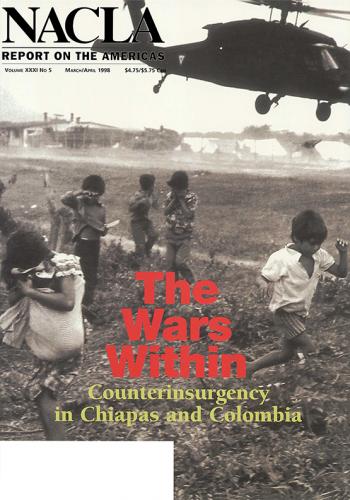Article
Colombia's northern plains were made for cattle. C~bu and Brangus cattle graze along the SinO River, which occasionally wanders out of its shallow bed, turning the land into a vast marsh.
The Thirtieth Anniversary Essay by Roger Burbach ["Socialism is Dead, Long Live Socialism," Nov/Dec 1997] presents some provocative argu- ments, and is a welcome opening of debate on the future of socialist movements in Latin America. I strongly disagree, however, with the fundamentals of Burbach's analysis and conclusions.
Senator Helms Proposes U.S.
Steven Dudley & Mario Murillo
As protests over the privatization of oil and the growing power of foreign capital are met with militarization and repression, Colombia's oil industry is becoming another theater of the country's ongoing war. On 65 different occassions in 1997, the National Liberation Army (ELN) attacked the pipeline installations of Colombia's state-owned oil com- pany, Ecopetrol.
The local priest was first to challenge the dark- ness in Guintar by stringing Christmas lights from the church steeple. Then someone hung lights above a nearby door and window.
Colombia's two nineteenth-century oligarchical par- ties, the Liberals and the Conservatives, still dom- inate the political arena at the close of the twentieth century. This fact alone separates Colombia from its South American neighbors, where traditional post-independence parties ultimately gave way to work- ing and middle-class political organizations and populist coalitions.
Shortly after the 1994 New Year rebellion, the Zapatistas and the government negotiated a cease-fire. Four years later, Chiapas has become militarized, alternating between negotations and violence-never truly at war but never truly at peace.
The New Politics of Inequality in Latin America: Rethinking Participation and Representation Edited by Douglas A. Chalmers, Carlos M.
Sterilization and Its Discontents Late last year, reports began circulating in the Lima press that women in remote rural areas of Peru were being forcibly sterilized. Two women reportedly died because of the hasty and unsan- itary conditions in which the steril- ization procedures were carried out, and numerous women say that they were pressured by government bureaucrats to have tubal ligations.
(far left) A young girl tries to protect herself from the rain in a temporary shelter for refugees of the Acteal mas- sacre last December. The camp is located in the mountain regions of the province of Chenalh6, Chiapas.
The massacre at Acteal last December was not an accidental or isolated event. In fact, it was a carefully planned act of war against Zapatista rebels and their supporters.
Over the past two years, the FARC has consolidated its presence in 622 of Colombia's 1,071 municipalities. This resurgence of the guerrilla is the direct result of the deep institutional crisis facing Colombian politics today.
The Zapatistas have touched a raw nerve in a political system that once seemed unshakable, prompting a military and paramilitary escalation of unprecedented proportions in southeastern Mexico. The residents of San Crist6bal de Las Casas were preparing their Christmas festivities on December 22, 1997 when reports of a massacre of 45 Tzotzil indigenous people in the highland community of Acteal, some 12 miles north, reached the town.
Paramilitary violence is not complementary to military strategy. In fact, the paramilitaries have come to replace the armed forces, which are mired in crisis as a result of their failure to defeat the guerrilla insurgency.
Recent local-level initiatives suggest that the key to a peaceful resolution of the conflict may reside in Colombia's towns and municipalities. Arecent article in The Washington Post describes Colombia as "the Bosnia of South America.
Steven Dudley & Mario Murillo
Outside the headquarters of Occidental Petroleum Corporation in Los Angeles, about 50 demonstrators gathered on October 20, 1997, carrying placards reading, "Oxy out of - Colombia" and "In Defense of the U'Wa." They were protesting plans by Occidental to begin oil explo- ration on the ancestral lands of the U'Wa, an indige ____ nous tribe of 5,000 which inhabits a vast territory that cuts through five departments in northeastern Colombia.
The year 1997 saw a dramatic escalation of violence in Chiapas and Colombia. The December 22 massacre of 45 unarmed civilians in Chiapas was only the tip of the iceberg.
Reviving the rhetoric of the Reagan/Bush years, Clinton Administration officials are once again pointing to the "narcoguerrilla" threat-erasing the already blurry line between counternarcotics and counterinsurgency in Colombia. In a throw-back to the Cold War, the nation with the worst human rights record in the hemisphere today- Colombia-receives more U.
Andrés Aubry & Angélica Inda
Paramilitary violence is not new in Chiapas. The men who make up the units now referred to as paramilitaries used to be called pistoleros (hired gunmen), or white guards.

